FODMAPs & Food Processing Series
Article 2: Part 1
In this installment of my FODMAP and Food Processing series, I will be focusing on how and why fermentation changes the FODMAP profile of dairy foods and sourdough bread.
You can also check out Part 2 of this deep-dive into fermentation, in which soy foods and cabbage are discussed, as well as the first article in this series on the effect dehydration, ripening, and storage conditions have on the FODMAP content in fruit.
- How Dehydration, Ripening and Storage Affect the FODMAP Content in Fruit
- How Fermentation Affects the FODMAP Content in Soy Foods and Cabbage

As I wrote in that first piece, I was reminded (and it is always surprising to note) that the same food can differ in FODMAP concentration depending on the environmental conditions it has been subjected to.
Because of this, the scientists at Monash University always test (and retest) every item they include in the Monash University Low FODMAP Diet Smartphone App. Consequently, my discussion will be limited to foods found in this essential resource.
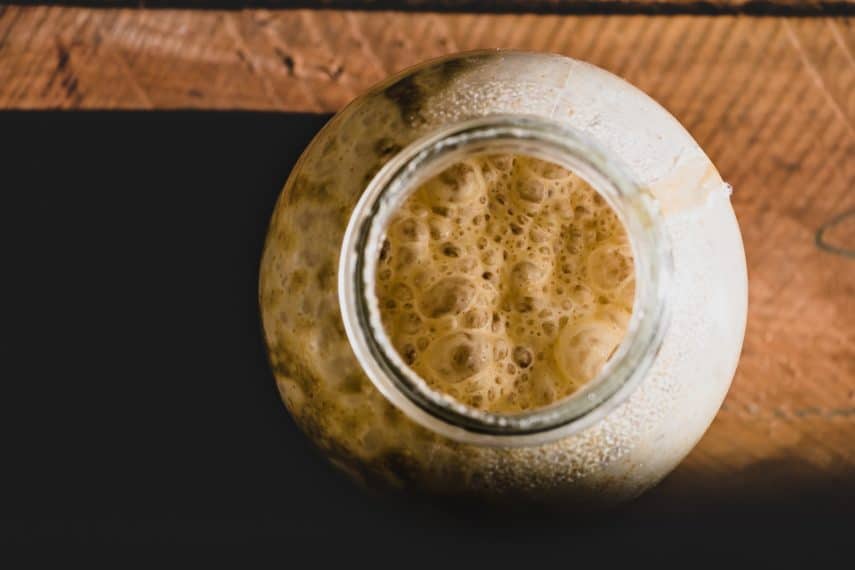
Fermentation 101
Fermentation has been used for millennia to preserve food and to enhance its nutritional benefits and flavor. In a nutshell, fermentation refers to the process of breaking down carbohydrates (remember, all FODMAPs are carbs) by exposing them to microorganisms such as bacteria, yeast and mold.
Sourdough bread, yogurt, kefir and cheese, as well as sauerkraut and soy products such as miso and tempeh, and are all examples of fermented foods.
Probiotics & The Microbiome
Two words that inevitably come up when discussing fermentation are probiotics and the microbiome. Anyone with an interest in (or problem with) their digestive system is probably familiar with both.
Just so you know in advance, this article is not going to be about probiotics or the microbiome because they are not relevant to the theme of this series, which is how various food processing techniques alter the FODMAP content in food.
Future articles on FODMAP Everyday® will delve into the complex and ever-evolving world of probiotics, but for a great review of the microbiome, check out my colleague Jody Garlick’s piece, The Microbiome Explained.
Digestible Dairy
In addition to changing the taste and appearance of milk, fermentation also makes it more digestible. Lactose, a disaccharide sugar (the “D” in FODMAP) found in milk, is notorious for causing bloating, gas and diarrhea in susceptible people.
These are folks who don’t produce enough lactase, the intestinal enzyme that helps break down lactose into more easily absorbed monosaccharide sugars. Lactose malabsorption may or may not cause symptoms, but when it does, it’s referred to as lactose intolerance.

Lactase & Dairy
These days, lactase-treated milk products are readily available, but long before food manufacturers got in on the act, fermented dairy foods were known to be easier on the digestive system.
The longer the fermentation period, the more opportunity the bacterial culture added to milk has to consume all that lactose.
This helps explain why aged/ripened cheese is much lower in lactose than fresh varieties such as ricotta, cottage cheese and cream cheese.
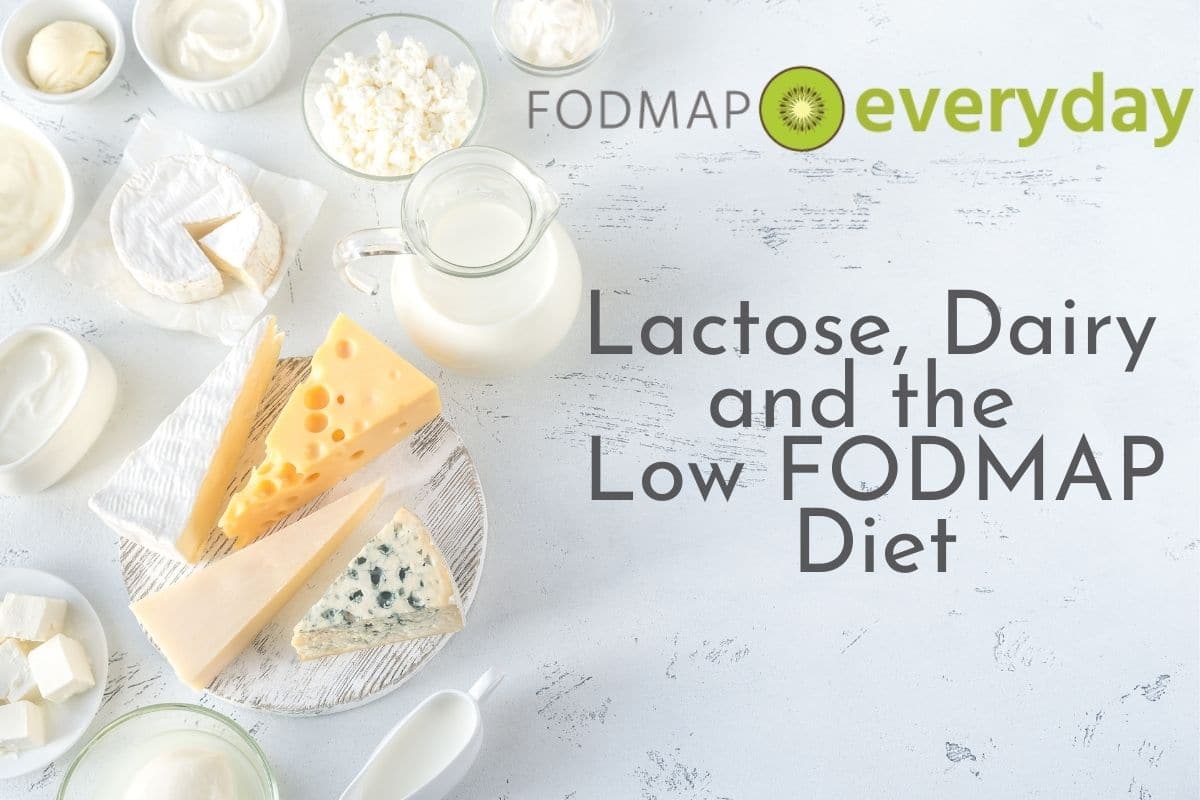
You may want to read: Lactose, Dairy and the Low FODMAP Diet
Similar to fresh cheese, most commercial yogurts and kefirs also undergo relatively short fermentation periods, which is why even those that boast live active cultures may still contain a hefty amount of lactose.
(FYI: Greek yogurt tends to be lower in lactose than regular yogurt because lactose accumulates in the liquid whey fraction that’s drained off in order to make a thicker product.)
DIY Lactose Free Yogurt
If you can’t find lactose-free yogurt in your local supermarket (or you can’t afford it) you can actually make your own with regular milk and a bacterial starter. It’s prepared in a very similar manner as regular yogurt, except you let the mixture ferment for 24 hours in order to allow the starter ample time to break down the lactose into digestible sugars. See Recipe below.
My suggestion to those who are lactose intolerant would be to start with a small batch or to use lactose-free milk and a lactose-free starter.
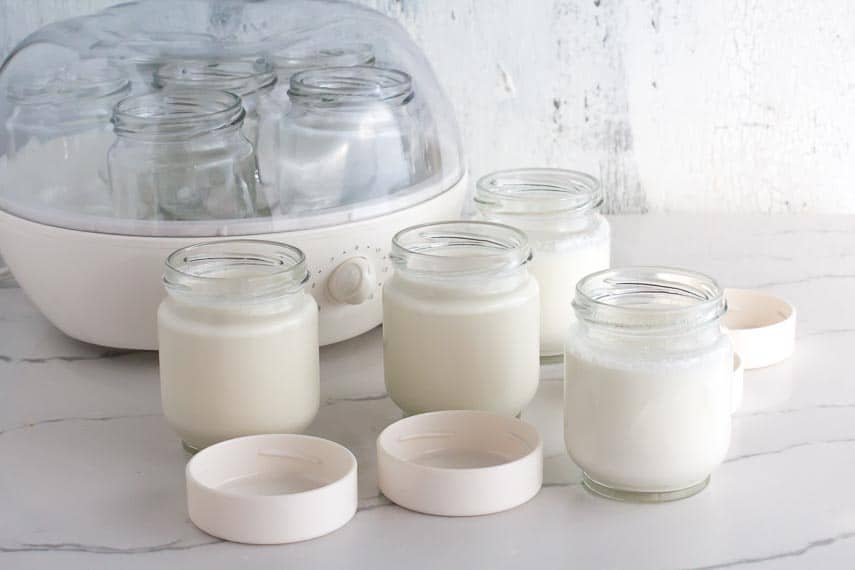
RECIPE: How To Make Lactose Free Yogurt
Making your own yogurt may not be your thing, but I bet you’ll be inspired by these FODMAP Everyday® recipes, which feature yogurt and other fermented dairy foods:
- Creamy Cucumber Dill Salad
- Easy Cheesy Quesadillas
- Cranberry Almond Buttermilk Bundt Cake This one also happens to be one of our FODMAP IT!™ entries, where we transform favorite high FODMAP recipes into ones that fit into a low FODMAP lifestyle.
Allergy Warning
One word of caution when it comes to all dairy foods: people who are allergic to milk must still avoid lactose-free products because there are other components in milk that can cause a potentially serious reaction.
Most packaged foods sold in the U.S. are required to list the top eight food allergens (which includes milk) if they’re used as an ingredient, so make sure to check for this if you have a milk allergy.
Sourdough Bread to the Rescue
Sourdough bread is of particular interest to FODMAPers because traditionally prepared sourdough versions made from spelt, wheat and other flours high in fructans (from the “O” FODMAP group) can be much lower in FODMAPs than regular bread made with the same flour.
And unlike many gluten-free breads that include a laundry list of ingredients, sourdough bread tastes like the real thing. Try one out in our Simple Sourdough Stuffing, a recipe so scrumptious it would be a shame to serve it only on Thanksgiving.
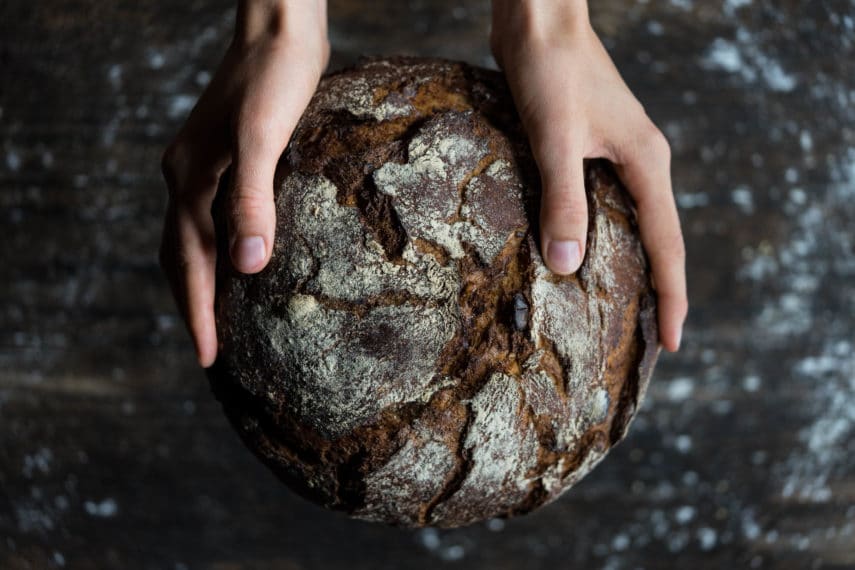
Instead of using baker’s yeast as leavening, traditional sourdough bread relies on a culture that contains lactobacillus bacteria and naturally occurring yeast. It is then left to rise for a much longer period of time than regular bread.
This prolonged leavening process allows the bacteria and yeast in the culture plenty of time to ferment carbohydrates, including fructans. In essence, these microbes gobble up FODMAPs before they get anywhere near your digestive tract!
Not All Sourdough Breads Are Low FODMAP
You can’t just run out and buy any old sourdough bread, however, because several of the ones listed in the Monash Smartphone App tested medium to high in FODMAPs. These items were unbranded, so I was unable to check if their rating was due to the addition of high FODMAP ingredients such as honey or high fructose corn syrup.
It was also impossible for me to determine if these breads were traditionally made, or if baker’s yeast or other ingredients were added to speed up the leavening process.
If you’re interested in testing your tolerance to sourdough bread, my advice to is to start out with a small serving of one that has been subjected to a long fermentation process and contains only flour, water and salt.
Even with those provisos, the results of two recent studies raise some questions and concerns.
More Research Is Needed
In this 2016 clinical trial, traditionally prepared sourdough bread was nearly four times higher in fructans (and produced more digestive symptoms in participants) than one made with the same ingredients that utilized a specific sourdough system.
This suggests that bread subjected to a long fermentation period may still be too high in fructans for people who are sensitive to this FODMAP category.
And in this 2017 pilot study, traditionally prepared sourdough bread with a low fructan content did not significantly improve subjects’ digestive symptoms when compared to a yeast-fermented (and gluten-enriched!) bread.
Furthermore, the authors of this pilot study reported “significantly more feelings of tiredness, joint symptoms, and decreased alertness when the participants ate the sourdough bread,” but concluded that this odd result was “likely due to chance, or a slight difference between the study groups at baseline.”
Current Sourdough Research
A March 2021 article in The International Journal of Food Sciences and Nutrition titled “Reducing FODMAPs and improving bread quality using type II sourdough with selected starter cultures” explains some current research.
Four breads were lab tested. Three breads made with white wheat flour and sourdough culture had an average reduction of fructans by 72%, with one reduced greater than 92%. The fourth bread made with yeast had a fructan reduction of about 20%, however, the fermentation time was maxed out at 6 hours for all of them.
What is the takeaway? That using sourdough culture yields a bread with lower fructans. That bread made with yeast also has lowered fructans. We do not know what the fructan reduction would be with a longer fermentation time but there is an indication that it would lessen even further. We also know from lab testing that sourdough breads that have the addition of yeast and a short 2-hour rise time can be low FODMAP. So the final conclusion, that Monash agrees with, is that you can never know for sure without lab testing.
The Takeaway
Whether due to chance or minor discrepancies in study design, the findings from both of these trials certainly provide food for thought! As always, work with your RDN to help you determine which foods are best for your unique system
Want to learn more about this subject? Read the other articles in this series:
- How Dehydration, Ripening and Storage Affect the FODMAP Content in Fruit
- How Fermentation Affects the FODMAP Content in Soy Foods and Cabbage
- You might also enjoy reading an Interview with Erica!
References:
- Frequently asked questions about FODMAPs (https://goo.gl/wEPKz4). Retrieved from https://www.monashfodmap.com
- Sourdough Processing & FODMAPs (https://goo.gl/tam8Rr). November 8, 2017. Retrieved from https://monashfodmap.com
- Laatikainen, R., Koskenpato, J., Hongisto, S.-M., Loponen, J., Poussa, T., Hillilä, M., Korpela, R. (2016). Randomised clinical trial: low-FODMAP rye bread vs. regular bread to relieve the symptoms of irritable bowel syndrome (https://goo.gl/X1GVfM). Aliment Pharmacol Ther. 44(5): 460–470.
- Laatikainen, R., Koskenpato, J., Hongisto, S.-M., Loponen, J., Poussa, T., Huang, X., Sontag-Stohm, T., Salmenkari, H., Korpela, R. (2017). Pilot Study: Comparison of Sourdough Wheat Bread and Yeast-Fermented Wheat Bread in Individuals with Wheat Sensitivity and Irritable Bowel Syndrome (https://goo.gl/sGvqwi). Nutrients, 9(11): 1215.

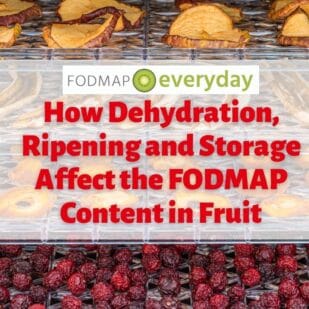
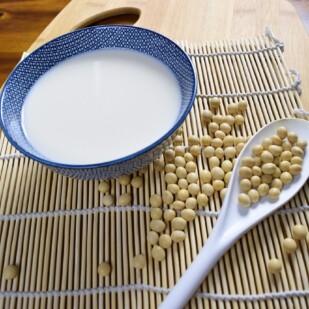



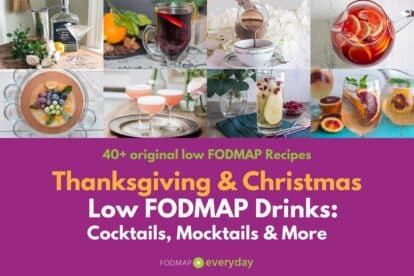

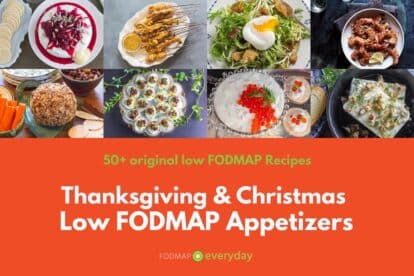
Which is better with regards to fodmaps- white flour sourdough or spelt flour sourdough? I’m looking into making my own but there are lots more recipes for white flour than spelt.
Or maybe whole wheat is better?
Hi is there a difference fodmap-wise between spelt, white flour, or whole wheat sour dough? Is one better than the others?
Hi Becky, I saw your two questions and we are actually working on an article right now about bread. The things with sourdough is that it is a living process and each loaf is going to be different. It is very difficult to control fermentation exactly time to time. So one white flour loaf one day could be different the next time. If you mean “better” in terms of lower in FODMAPs, if a bread is not lab tested it is hard to say. I am cutting and pasting some info for you here that is from the upcoming article specifically about spelt.
“Can I eat spelt bread? I am confused about spelt.” (This is how we are posting the question)
We understand your confusion! Looking at spelt information in the Monash app is dizzying. Spelt flour has been lab tested and is considered high FODMAP, but if you look at the amount, it is large. For instance, wholemeal spelt flour is high FODMAP at 2/3 cup or 100 g. Sieved organic spelt flour, however, is low FODMAP in the same amounts. This tells us, in part, that the bran, which would be somewhat or largely removed in the sieved product, is FODMAP rich. Then within the small print of some entries within the Monash app they mention that the fermentation of the sourdough process can lead to a low FODMAP spelt bread, and indeed there are several low FODMAP sourdough spelt breads listed.
BUT, and this is a big but, and is where confusion reigns, there is also an entry for 100% spelt bread – not sourdough – and it, too, is low FODMAP even at 2 slices or 70 g. Then, we can also find Inewa Spelt Bagels, which are lab tested and certified as low FODMAP. So, what to think? If a product is lab tested and certified, like these bagels, or Pure Life Bakery Organic Sprouted Spelt Bread, then we know for sure that the product is low FODMAP in the serving sizes suggested. In terms of spelt bread products that are not lab tested, we suggest starting with the equivalent of 1 slice or about 30 to 40g. YOUR individual reactions, assessed during your Challenge Phase are the ultimate arbiter.”
There will also be sections on sourdough.
Thank you so much! Sorry about the double responses, my phone glitched and I thought the question got lost the first time so I resubmitted.
No problem!
Fuller entries regarding sourdough will be SOOO helpful!
We have a 6000 word How To Choose Low FODMAP Bread coming up very soon!
Your description of the 2021 study seems to me to suggest that three of the breads were raised with only sourdough and the fourth with only baker’s yeast. Re-reading the study report, I’ve just realised that it says the experimental protocol involved using baker’s yeast in all four doughs, and then the 3 ‘sourdough’ samples
“were supplemented with 15% (w/w; on the weight of the flour) of sourdough”.
That has a different implication for commercial breads (and other products) made with both baker’s yeast and sourdough, reinforcing your point in your final paragraph about breads with both yeast and sourdough and with an even shorter fermentation time.
Your final point that “you can never know for sure without lab testing” is definitely true, but for individuals it comes back (as usual) to needing to test for ourselves whether specific ‘sourdough’ breads affect our individual idiosyncratic guts.
It is ALWAYS about individual tolerance – with sourdough or any other lab tested food. Lab tests are lines in the sand from where to begin one’s exploration of FODMAPs and what YOUR reactions are. And those reactions might be less, the same or more than the lab tests state. And, your tolerances will most likely change over time, and can also vary day to day.
“traditionally prepared sourdough bread” means different methods depending on the baker’s background/country or which culture the bread originates from. For example I have always used the French approach which takes about 5 days until you can make a dough. It uses very little flour to make the “chef”, especially compared to some American recipes which can sometimes use 2-3 lbs with most discarded.
I know that I will have to see how I tolerate the bread I make using my usual French based approach. Since I can’t send samples to Monash U. 😉
Our reactions are quite individual! Enjoy your baking and we hope you get a positive outcome in your relationship to your finished product.
Thank you very much for sharing this, do you have any ideas about the change of sourdough in pure gluten-free breads made of rice, sorghum, tapioca, potato starch and Millet flour? I have a gluten free rice based sourdough starter and the typical ripening time is 8 hours. Looking forward to your opinion here
Definitely check out our BREAD article, too. As we say in the article, there is no way to determine the FODMAP content of anything that is fermented unless it is lab tested. I am curious why this would matter to you, since the blend of flours you mention would be low FODMAP anyway?